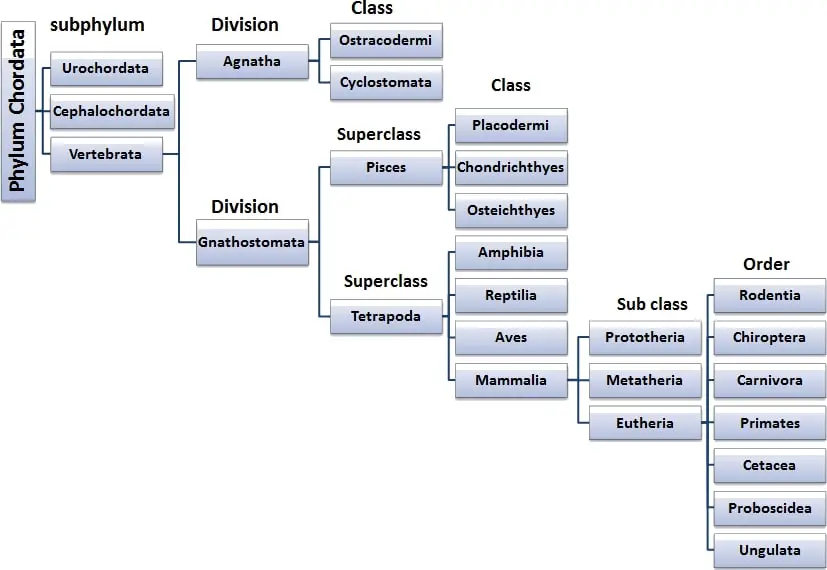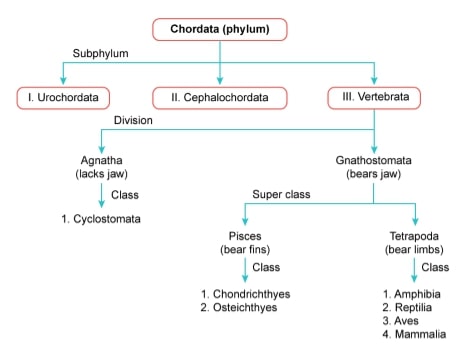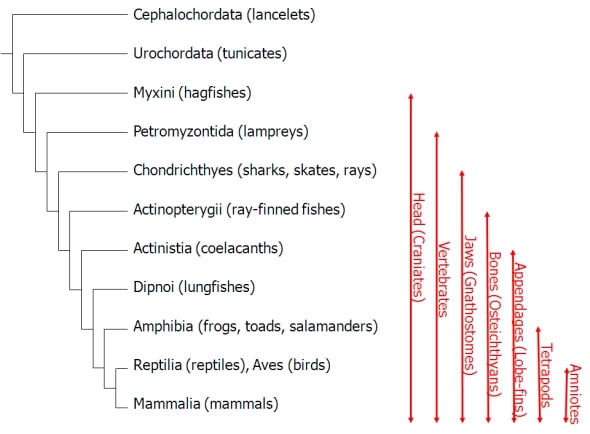If we study all members of phylum Chordata then we will find great variation in their characters and due to this great variation, it is not so easy to divide them into different groups accurately.
But the great effort of different taxonomists enables us to study them in different groups and different taxonomists present different approaches to classify them into different groups and we can not discuss all of them together now so we will try to discuss the most simplified and accepted approach for classification of phylum Chordata.
Table of Contents
Phylum Chordata:
It is a group of notochord-bearing animals with bilateral symmetry and they show great variation in size, shape, they are adapted to almost all types of environmental conditions.
Phylum Chordata contains triploblastic animals with metamerism and they have true coelom and they are deuterostome in nature.
It is assumed that Chordata evolved during the Cambrian period and in their life cycle, 3 fundamental character is very important- dorsal hollow nerve cord, notochord, and pharyngeal gill slits.

On the basis of the presence of proper head phylum Chordata is divided into two groups, one is Acrania or Protochordata and another group is Craniata or Euchordata, both groups we have discussed below in depth.
Group A: Acrania or Protochordata:
The world Acrania refers to the absence of cranium or head and the word Protochordata indicates that this group is a very primitive member of phylum Chordata.
In this group there are around 2000 species with no jaw, no cranium or head, vertebral column absent all Protochordate are marine.
On the basis of positions of the notochord, Protochordata is further divided into three subphyla – Hemichordata, Urichordata, and Cephaochordata.
Subphylum I: Hemichordata:
The body is divided into three parts, proboscis, collar, and trunk, the notochord is very small and does not extend along the whole length of the body the notochord in the Hemichordata is limited in proboscis region only.
Class1: Enteropneusta:
This class of subphylum Hemichordata contains animals with numerous gill slits and the intestine is straight with a long worm-like body shape, for example – Saccoglossus and Balanoglossus.
Class 2: Pterobranchia:
In this class gill slits is one pair or absent, the intestine is not straight, it is U-shaped and the body is short, an important member of this class is Cephalodiscus.
Class 3: Planctosphaeroidea:
The body is rounded and transparent with a special larval stage Tornaria which has highly branched ciliary bands and the alimentary canal is L-shaped, for example, Planctosphaera pelagic.
Class 4: Graptolita:
They are extinct Hemichordate and they generally live in colonial form, a special feature of this class is the presence of tubular chitinous exoskeleton, important fossil evidence of this class is graptolites.

Subphylum II: Urichordata or Tunicata:
The word Tunicata is due to their special protection sheath outside their body known as the tunic and they are mostly sessile with the sac-like body. Their life cycle has special tadpoles like larvae and the notochord in them is not persistent through the life, notochord is only present in their larval stage.
Class 1: Ascidiacea:
They are mostly sessile and the tunic is slightly muscular, they are also known as Sea Squirt or Ascidian. They present in a colonial form or solitary, some of them form complex associations, some important members are Ciona, Herdmania.
Class 2: Ascidiacea: Salps or Chain Tunicates:
They are mostly free-swimming, pelagic and some of them form colonies, their tunic has circular muscle, an important member of this class is Salpa, Doliolum.
Class 3: Larvacea or Apendicularia:
They are very small, free-floating, transparent tunicates with around 20 species. Their larval stage has a tail-like structure and the number of gill slits is two pairs, one important member of this class is Oikopleura.
Subphylum III: Cephaochordata:
In this subphylum, the notochord and nerve cord are persistent in the entire life and the notochord extends the entire length of the body from head to tail.
Class Leptocardii: Lancelets:
They are fish-like animals with numerous gill slits in pairs, their endoskeleton is bony. They are free-swimming and burrowing, metamerism is clear in their segmented muscle myotomes. They have two genera, one is Branchiostoma and another one is Asymmetron.
Group B: Craniata or Euchordata:
This is the group of Chordata that includes higher or advanced chordates and it has only one subphylum Vertebrata. They have proper brain protection inside the brain box or cranium, the notochord is replaced by the vertebral column, some of them have jaw.
Subphylum IV: Vertebrata:
This is the largest subphylum of Chordata with more than 26,000 species and the notochord is replaced by vertebral column made by vertebrae.
The vertebral column or backbone is a very important feature that makes them advanced over other groups of Chordata.
The body is divided into a well-defined head, neck, trunk and post-anal muscular tail, the subphylum Vertebrata is further divided into two divisions- Agnatha and Gnathostomata.
Division I: Agnatha:
They are primitive vertebrates with paired limbs but they do not have jaw and they are further divided into two classes – class Ostracodermi and class Cyclostomata.
Class 1: Ostracodermi:
They are very primitive vertebrates on the earth and they are now extinct, the body has been heavily armored, they are also known as Ostracoderms and one important member of this class is Drepanaspis.
Class 2: Cyclostomata:
The name Cyclostomata is due to their jawless rounded mouth which is suctorial in nature, 5-16 pairs of gill slits, the body is eel-shaped. No lateral fin, no scale, this class has around 45 species, most of them are parasitic in nature and some important members of class Cyclostomata are Petromyzon, Myxine.

Division II: Gnathostomata:
Gnathostomata have a true jaw that encircles the mouth opening and they are further divided into two superclasses – Pisces and Tetrapoda.
Superclass 1: Pisces:
They are aquatic Gnathostomata with paired fin and the body have to scale, they include all fishes.
Class 1: Placodermi:
They are primitive extinct fishes with armored body and the head was movable because the head shield was articulate in such a way to the body shield so that the head can move, some important members of the class Placodermi are Climatius, Dinichthys.
Class 2: Chondrichthyes:
They are mostly marine fishes in which the endoskeleton is made of cartilaginous tissues and other features of Chondrichthyes are placoid scale, gill slits are not covered by an operculum, they have around 600 species, most important members are Scoliodon, Chimaera.
Class 3: Osteichthyes:
They are bony fishes that live in both freshwater as well as in marine, scale is ctenoid, cycloid, gill slits are covered by an operculum, they have around 20000 species and some members of class Osteichthyes are Labeo, Hippocampus.
Superclass 2: Tetrapoda:
They do not have a fin, instead of a fin they have pentadactyl limbs in pairs and lungs for respiration and cornified skin.
Class 1: Amphibia:
The word amphibia refer to their dual life, larval stage in water and adult terrestrial stage, during the larval stage, they respire through their paired gill and when they become adult they respire through lungs. Their heart is 3 chambered and skin is highly vascular, moist, and glandular, some important members of class Amphibia are Rana, Bufo.
Class 2: Reptilia:
They are creeping animals with or without limbs, body covered with horny scale, cold-blooded, the heart is incomplete 4 chambered. The primary respiratory organ is the lung and some important members of class Reptilia are Hemidactylus, Naja.
Class 3: Aves:
They are feather-covered flying vertebrates and generally known as birds but all the birds are not able to fly. Due development of flying ability they have some specific adaptations to reduce their body weight and minimize air resistance. Forelimb are converted into featured wings, the mouth is covered by beak and teeth are absent in their beak, the heart is complete 4 chambered, some important members of class Aves are Columba, Gallus.
Class 4: Mammalia:
They have mammary gland to feed young ones, body have hair and skin is the glandular, completely four-chambered efficient heart, some important members of class Mammalia are Homo, Echidna, Rattus.
Detailed Study on
Difference Between Chordata and Nonchordate
Phylum Chordata General Characteristics Features
Why Chordate are Advanced than Nonchordate
Chordate and Higher Non-chordates Similarity
Phylum Chordata 3 Fundamental Character
Phylum Chordata and Its Diversity
Chordata Definition with Examples
Resource: Classification of Phylum Chordata
Hi Everyone!!! Welcome to Imaluop. Imaluop always try to learn some new and he want to share to other people. Here we will try to learn various topics on Science, specially on Biological Sciences.